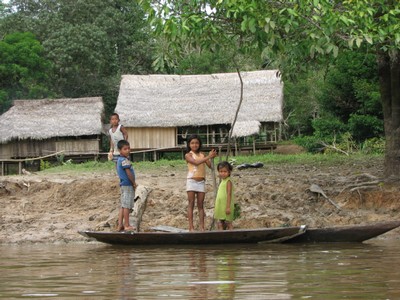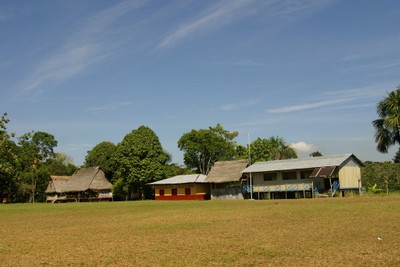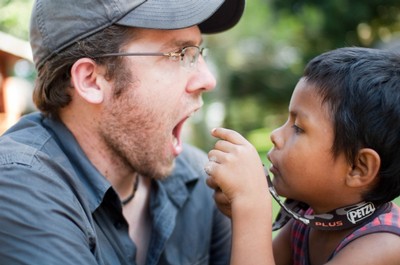Science in the Amazon
The boys from the Amazonian orphanage decided to name themselves Los Científicos. The Scientists.
It was a small but monumental achievement for Rick Henrikson and Richard Novak, two Berkeley bioengineering graduate students. The pair cofounded Future Scientist, a tiny but highly motivated aid organization whose mission is to teach science and practical technical skills to young people in rural, developing regions.
Last August, Novak, Henrikson and nine other Future Scientists traveled to Peru for their first pilot project: teaching a two-week crash course on pathogenic microorganisms, disease transmission, optics and solar-powered electricity to schoolchildren living along the Amazon River.
“We don’t want to do charity,” Novak, 24, explains. “The problem with many global aid organizations is that they’re product based. They donate resources, but the resources eventually run out. The large piece of equipment breaks and no one knows how to repair it. We’re taking a different approach.”
Arriving by boat, the Berkeley visitors proffered simple science lessons of a practical nature, purely optional. Thirty children from the Casa Girasoles Orphanage and community of Puerto Alegría showed up to their informal school.
Together, teachers and students collected water near the village and viewed it under microscopes schlepped from California. They identified invisible organisms that make people sick, talked about water pollution and practiced simple filtration techniques. They examined the microscopes themselves, learned how they’re built, how to work them and what useful things they reveal. (The microscopes and other equipment were later given to the community school.) The children played with magnifying glasses and learned the basics of optics.
Next, the teachers brought out small, solar panel kits to collect solar energy. The group made solar-powered radios, exploring electromagnetic waves and radio transmission. In this part of the world, with no reliable electricity, they soldered wire and assembled electrical components, then danced to the music gleaned from the airwaves. Finally, the children formed teams to compete in a solar oven–building contest.
To measure their work, the Berkeley teachers surveyed the children before and after the lessons; their results showed the material was sticking. “They were excited about what they were learning,” Novak reports. The nascent organization hopes to empower children with enough practical know-how so that, 10 years from now, these young adults can address their community’s needs—good health, electricity, sanitation, jobs—with solutions of their own.
Henrikson, 26, first saw a need for outreach to rural areas when he volunteered for a community health care organization in the Dominican Republic. Henrikson, who has a bachelor’s degree in chemical engineering from MIT, became a reluctant object of admiration among the people he met there. “They saw the benefit of a science education, and I was moved to do something that would support that need,” he says.
When he arrived at Berkeley, Henrikson met Novak, a fellow first-year graduate student in bioengineering with a bachelor’s degree in biology from Emory University. Between high school and college, Novak had worked at a research station deep in the Amazon. He watched as malaria sickened nearly half the local population and observed firsthand the consequences of ignorance about concepts as simple as disease transmission. Novak and Henrikson became roommates and spent long hours discussing ideas for how to help.
In the meantime, they volunteered for a science outreach program to Bay Area schools and met bioengineers similarly motivated: Tyson Kim, Sisi Chen, Frankie Myers, Gautham Venugopalan — eight graduate students in all — plus two professional engineers and a high school science teacher. Someone knew someone who had a contact at the Casa Girasoles Orphanage in Peru, and plans coalesced.
In January 2009, Future Scientist was born. Later, the group won funding from the Clinton Global Initiative and other donors, enough to buy equipment for their first batch of science lessons. Airfare to Peru and other travel expenses would come out of members’ own pockets.
A shoestring budget didn’t prevent the travelers from making the most of their time in the Amazon. When they weren’t teaching lessons, the group met with local teachers and health care workers to survey people’s needs, an important part of Future Scientist’s collaborative approach.
Back in Berkeley, the group is fundraising and writing a business plan while refining its curriculum and developing new hands-on science lessons. The next step is to recruit more volunteers to teach in the Amazon and continue the work launched last August.
Two members of Future Scientist returned to the Amazon last month to launch a new project (and blog about it). They’re installing a customized biogas digester system and teaching the villagers how to run it, hoping to spark a cottage industry there. Digesters, already employed in many parts of the developing world, are airtight tanks that convert farm scraps, human waste and organic matter into methane-based cooking fuel and nitrogen-rich fertilizer through anaerobic digestion. It’s a low-cost and sustainable way to improve sanitation and kill pathogens. Simple science sustaining life in the rainforest.























